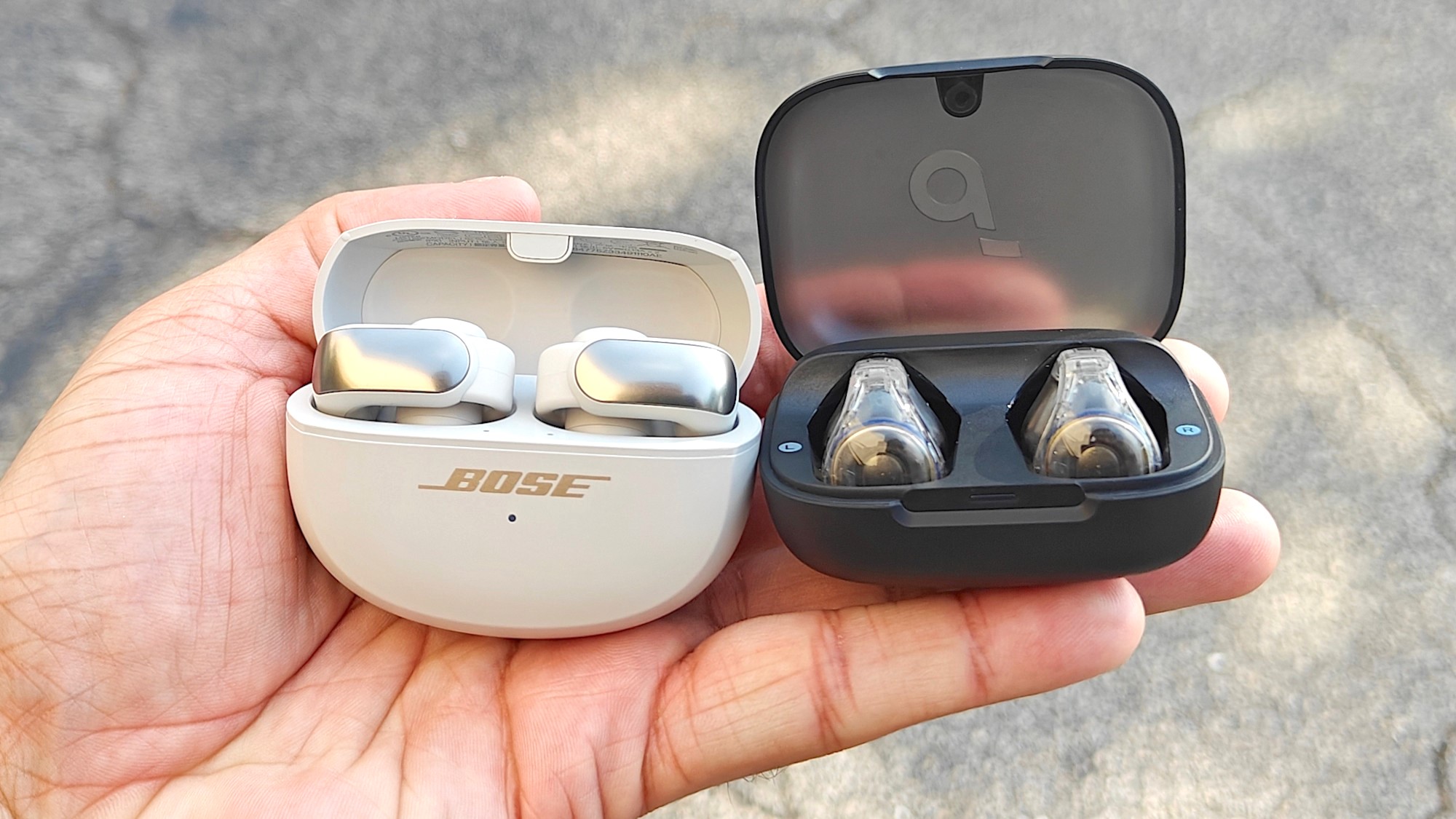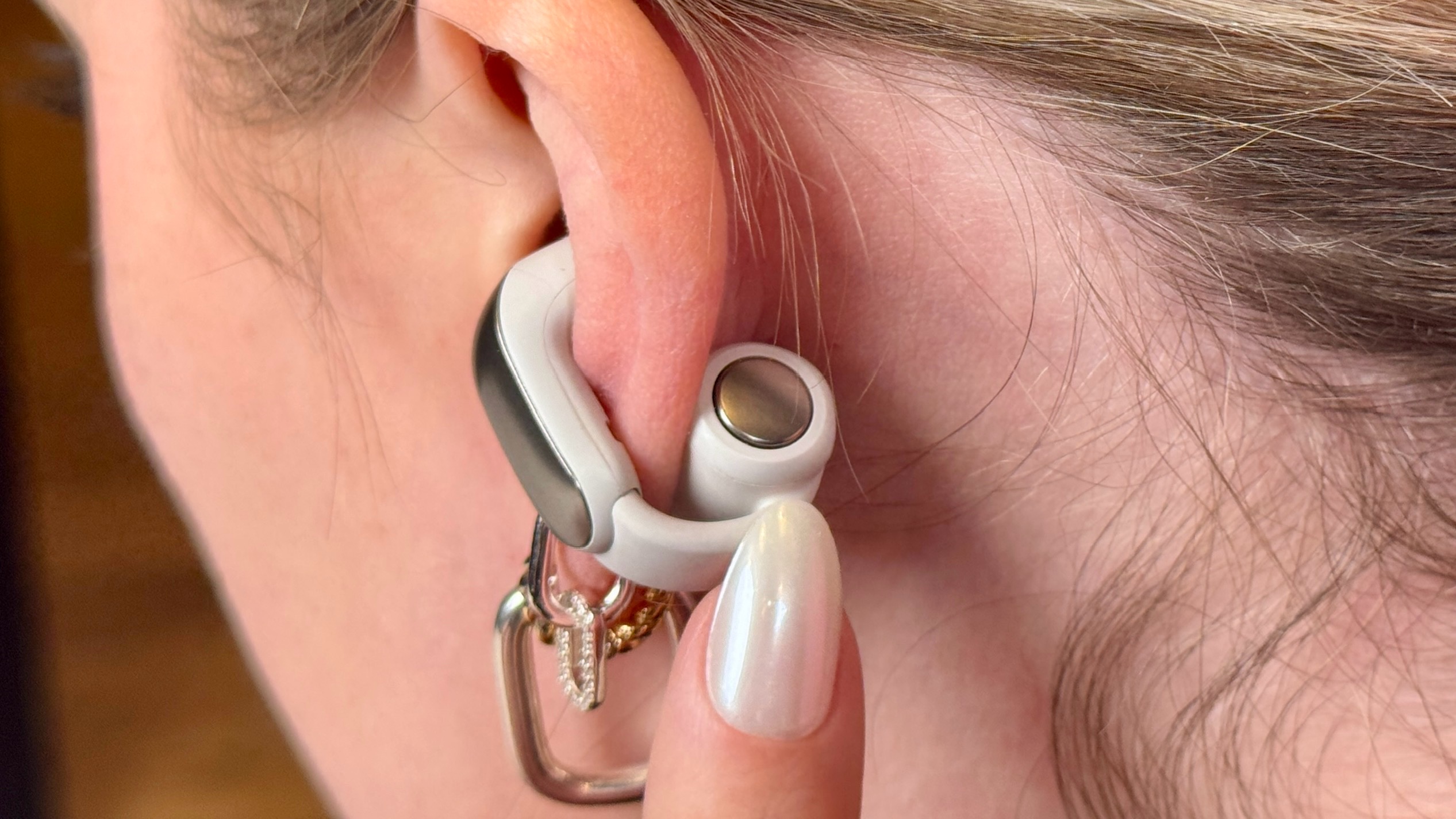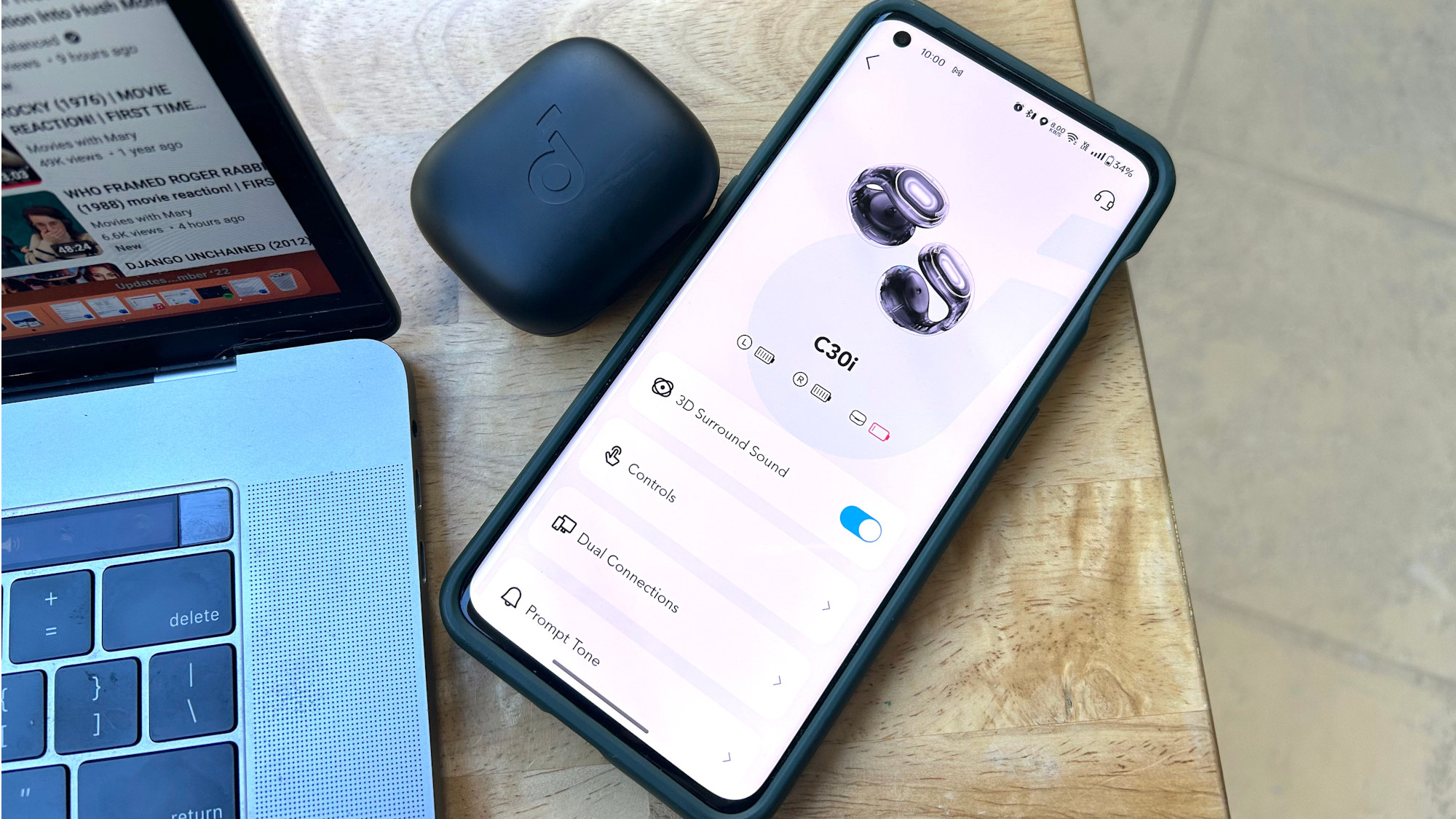
The Bose Ultra Open Earbuds are sleek open earbuds that provide premium sound and wide transparency in an ultramodern design.
For
- Barely-there feel
- Spatialized listening
- Very little sound leakage
- Great battery life
Against
- Seem easy to lose
- Mediocre call quality
- Case doesn’t support wireless charging
The Soundcore by Anker C30i are entry-level open earbuds with strong audio performance and battery life, plus they’re designed for optimal on-ear stability.
For
- Innovative design with secure fit
- Clear, energetic sound
- Lengthy battery life
Against
- Poor touch controls
- Ineffective spatial audio
- Connectivity and software issues
The open earbuds market is expanding so quickly that we’re already seeing sub-categories introduced. New to the scene are clip-on earbuds, which operate similarly by letting you hear music and your surroundings at the same time, except they attach to the outer part of your ears instead of hooking on.
Two of the most popular models sold are the Bose Ultra Open Earbuds and the new Soundcore by Anker C30i. Bose’s on-ear alternative to the critically acclaimed QuietComfort Ultra Earbuds stuffs high-end features (e.g., aptX Lossless and spatial audio support) in one of the most creative true wireless designs I've seen, while Soundcore’s latest creation follows suit with a unique look and proprietary technologies.
Scroll down to see how the Bose Ultra Open Earbuds and Soundcore C30i compare in terms of specs, design and performance.
Bose Ultra Open Earbuds vs. Soundcore C30i: Specs compared
Bose Ultra Open Earbuds vs. Soundcore C30i: Price & availability
Bose sells the Ultra Open Earbuds for the same price as its flagship QuietComfort Ultra Earbuds ($299). Meanwhile, Soundcore has the C30i available for $69, which is less than a quarter of their rival’s MSRP, making them the more enticing option.
Both products can be purchased on their respective company websites or major online retailers including Amazon and Best Buy.
Winner: Soundcore C30i
Bose Ultra Open Earbuds vs. Soundcore C30i: Design

These are two attractive open-ear designs. I prefer the Ultra Open Earbuds for their style and pleasant comfort. The flexible arms apply very little pressure to ear cartilage, latch on easily, and provide a tight fit. The IPX4 rating for durability means they're protected from moisture ingress to enable users to exercise with them. Bose’s charging case is compact and slim for storage in denim pockets or your everyday bag.

Soundcore took some inspirational liberties with the C30i’s design by borrowing elements from their competitor, along with a see-through shell. Overall, the buds have a very stylish look. While advertised as clip-on buds, they’re really slip-on buds that slide in over the outer part of your ear. They offer adequate comfort and fit, thanks to the bundled attachable grips. The charging case is where the buds lose cool points. It’s generic and lacks the buds’ innovative detailing.
Winner: Bose Ultra Open Earbuds
Bose Ultra Open Earbuds vs. Soundcore C30i: Controls

The Bose Ultra Open Earbuds come with multifunctional buttons and the Soundcore C30i employ touch controls. Both sets of buds grant access to basic functions like call management, digital assistance, and playback. You can adjust volume directly on Soundcore’s buds. Bose lets you enable automatic switching, listening modes, spatial audio, or voice assistance on their buds through the shortcut input (long press). Google Assistant and Siri perform well on both models for hands-free voice commands.
If only the C30i’s touch controls were practical. Touch detection was poor during my tests, and the panels are difficult to locate at times since they’re awkwardly placed on the back of each bud. The Ultra Open Earbuds’ MF button is conveniently on the top and produces great tactility that ensures listeners that commands are being met.
Winner: Bose Ultra Open Earbuds
Bose Ultra Open Earbuds vs. Soundcore C30i: Sound quality

The Ultra Open Earbuds have a few audio advantages over the C30i. For starters, they use the same 12mm drivers as the QC Ultra Earbuds to dish out crisp, full-bodied sound. You can toy with the EQ to adjust bass, treble or mids, though the buds sound great right out of the box. The Bose Music companion app also has multiple listening modes to tweak frequency range based on everyday scenarios (e.g., Focus, Relax), along with a Stereo mode that gives music a dynamic presence. Bose’s Immersive Audio mode with headtracking delivers convincing 3D sound — no matter the content. Lastly, aptX Adaptive and Lossless codec support deliver the highest-quality audio over Bluetooth.
Soundcore stuffed 12mm x 17mm racetrack drivers into the C30i that create a nice mix of impactful lows and neutral mids. SBC and AAC perform well for steady playback on the best music streaming services. You'll want to skip the 3D Surround Sound mode though, since it made everything I played during in my tests sound hollow and unnatural.

One of the main reasons to buy open earbuds is to stay aware of incidental sounds. You’ll be glad to hear that the Ultra Open Earbuds and C30i offer terrific transparency. Just remember that ambient noise can affect sound quality.
Winner: Bose Ultra Open Earbuds
Bose Ultra Open Earbuds vs. Soundcore C30i: Special features

Bose equipped their buds with more functionality. The list includes auto volume, control shortcut, device switch enabling, and the previously mentioned audio features (EQ, Immersive Sound, Modes). A volume slider, firmware updates, product tips, and battery level indicators round out the Bose Music app.
The C30i don’t carry as many features as other Soundcore earbuds and headphones I've tested. Aside from Immersive Sound, you get multipoint technology to pair to two devices simultaneously, and standard Soundcore app perks (battery level indicators, control customization, prompt tones). There’s a software update that adds a custom EQ to personalize sound. We never got a chance to try it since every download attempt resulted in “an error occurred” message.
Winner: Bose Ultra Open Earbuds
Bose Ultra Open Earbuds vs. Soundcore C30i: Call quality

Neither set of clip-on buds should be used for voice or video calling due to their low volume, poor vocal capture, and weak noise reduction. Callers on the opposite end sounded clear, but we received complaints about muffling and lots background noise, which made it difficult to carry a conversation.
Winner: Tie
Bose Ultra Open Earbuds vs. Soundcore C30i: Connectivity
Each model runs on Bluetooth 5.3. The Ultra Open Earbuds have higher quality audio capabilities over Bluetooth courtesy of aptX Adaptive and Lossless codec support that delivers streaming bitrates of up to 420kbps and 1,200kbps respectively. Range extends up to 50 feet. Pairing is instantaneous, especially on Android devices via one-tap Google Fast Pair.
The C30i suffer from several connectivity issues. If they aren’t draining power by staying connected to a device when stored in their charging case, then you’re probably dealing with only one bud working or not being able to download the latest software update.
Winner: Bose Ultra Open Earbuds
Bose Ultra Open Earbuds vs. Soundcore C30i: Battery life

A full charge on the C30i equals 10 hours, whereas the Ultra Open Earbuds max out at 7.5 hours. We’ll happily take the extra playtime provided by Soundcore’s buds. Quick charging is almost identical, though the C30i generate an hour more during a 10-minute charge to give you 3 hours of use. Furthermore, the C30i’s charging case holds more juice: (30 hours versus 27 hours).
Winner: Soundcore C30i
Bose Ultra Open Earbuds vs. Soundcore C30i: Verdict
If clip-on earbuds pique your interest, then the Bose Ultra Open Earbuds are the way to go. Bose’s OpenAudio technology does a terrific job of feeding your ears rich, well-balanced sound and high transparency. Immersive Audio is sufficient for lively listens. The design is also a work of art that perfectly blends form, function, and fashion. They’re a big investment at $299, but these are the category’s top offering.
The Soundcore C30i are more attainable at $69, but they can’t compete with most mid-range or luxury selections. Sound is surprisingly great, playtimes are lengthy, and the design is stylish. Unfortunately, Soundcore failed to strengthen the most basic aspect of a wireless audio headphone: usability. The poor touch controls and connectivity issues hurt their appeal.







